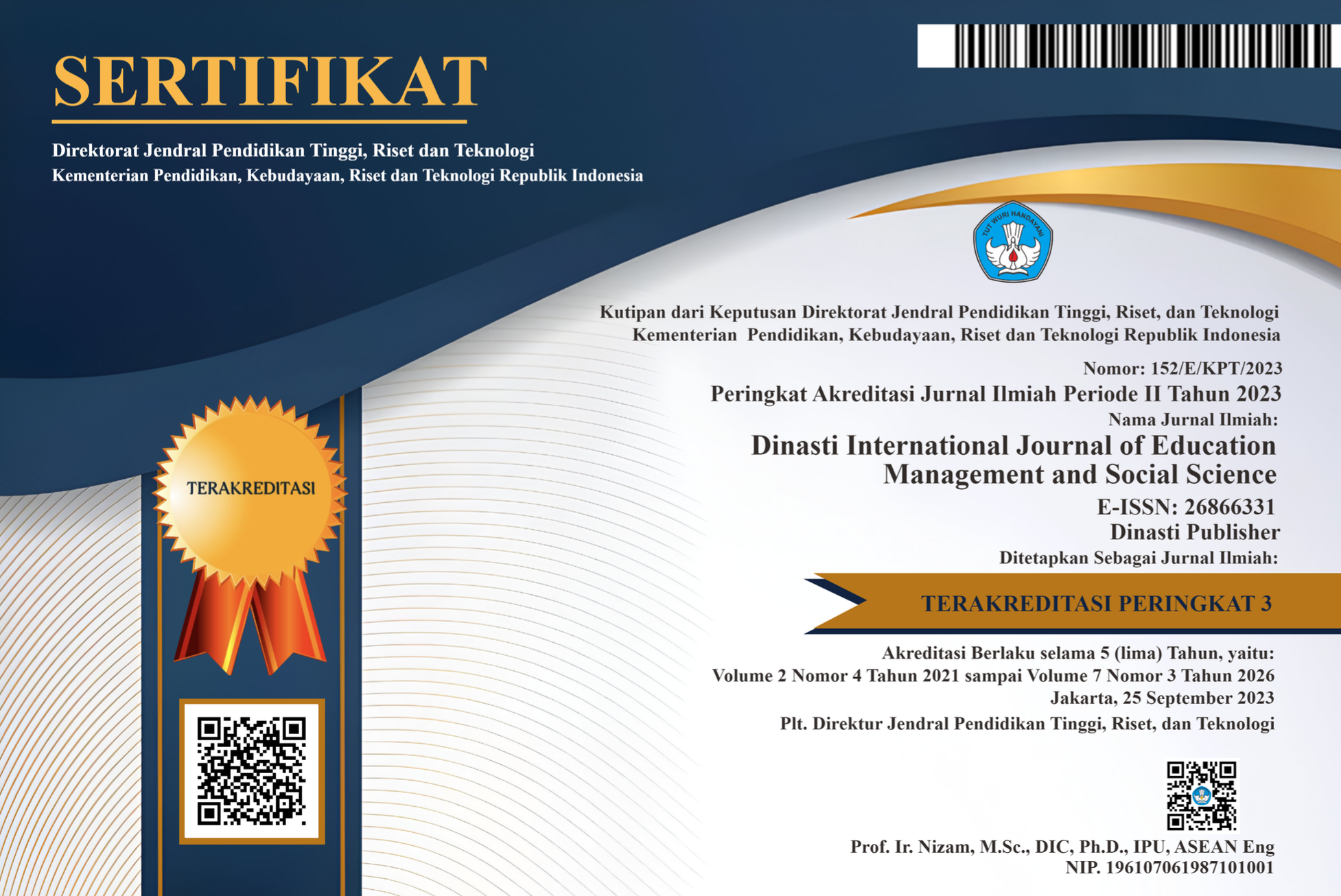THE REPRESENTATION OF SUMBA WOMEN IN THE FILM MARLINA THE MURDERER IN FOUR ACTS (AN ANALYSIS OF CHARLES SANDERS PIERCE)
DOI:
https://doi.org/10.31933/dijemss.v3i6.1345Keywords:
Film, Women, Sumbanese, SemioticAbstract
Violence against women is still common in a modern era like today, not least for women who live in the rimland region. Women are often used as a violent objects by men. The patriarchal culture still embraced by some people makes it difficult for women to fight against male domination in their environment. This makes it difficult for women to fight against male domination in their environment. Especially for Sumba women, whose society still adheres to the patriarchal culture. The movie "Marlina, The Murderer in Four Acts" describes the form of resistance of a Sumbanese woman against the injustice that befell her due to men who still lower their self-esteem. This film shows that a woman is not a weak figure; they can fight people who lower their self-esteem with their own hands. This research itself uses qualitative research methods using Charles Sanders Pierce's semiotic analysis in analyzing the data. The result of the analysis of the representation of Sumbanese women in the film "Marlina The Murderer in Four Acts" (1) shows the gender inequality that occurs in Sumba society in the film due to the patriarchy that prevails there, (2) violence and harassment against women and (3) form of women's resistance to the violence and abuse they experience.
References
Astuti, Ari Puji. Representation of Women in the Film 7 Hati 7 Cinta 7 Wanita, State Islamic University of Sunan Kalijaga Yogyakarta, Communication Studies Program, 2013.
Bandung, 2013.
Bula, Asra. 2020. Give Sumba Women Freedom. Retrieved July 17 2021 at 22:24 fromhttps://www.sambavoice.com/2020/06/beri- island-women-freedom-space.html
Canadian International Development Agency(CIDA), 1997. “Guide to Gender Sensitive Indicators
Daryanto and Rahardjo, Muljo. Communication Theory, Gava Media, Yogyakarta, 2016.
Dianingtyas, Edwina Ayu. Representation of Javanese Women in the Film RA Kartini,
Hoed, Benny. Semiotics and Socio-Cultural Dynamics, Bamboo Community, Depok, 2011.
Hutriips.ugm.2021. Why Does Patriarchal Culture Still Exist in Indonesia? Here's the reason!. Retrieved July 17, 2021 at 22:12 fromhttps://id-velopedia.velo.com/why-sih-kultur-patriarki-masih-ada-di- indonesia-here-the-why/
Inrasari, Goddess. Representation of Minangkabau Culture in the Film Sinking of the Van der Wijck Ship (Film Semiotics Analysis). Salaudin State Islamic University Makassar, 2015.
Kriyantono, Rachmat. Practical Techniques for Communication Research, Kencana, Jakarta, 2007. Moleong, Lexy J. Qualitative Research Methodology, PT. Rosdakarya Youth,
Littlejohn, Stephen W. Communication Theories of Human Communication.
Lubis, Khoirul Rozi. Women's Representation in the Media (Quantitative Content Analysis on Women's Reporting in the Waspada Daily), University of North Sumatra, Communication Studies Program, 2018.
Maulana, Murad. 2016. Knowing Charles Sanders Pierce's Thoughts About Semiotics. Retrieved August 24, 2021 at 21:27 fromhttps://www.muradmaulana.com/2016/09/menkenal-pemikiran-charles- sanders.html
Oscarumbu, 2020. Married and Captured on Sumba Island in Tomb Patriarchal Culture. Retrieved 17 July 2021 at 22:24 fromhttps://www.kompasiana.com/oscarumbu/5efc629ed541df54c661b9f2/kawi n-catch-in-the-culture-patriarchal-vortex
Communication Specialist. 2017. The Semiotic Theory of Charles Sander Peirce – Sign – Object – Interpretant. Taken from:https://pakarkomunikasi.com/theory-semiotics- charles-sanders-peirce. (10November 2017)
Ramelan, Robin. Sumba Culture Volume 1. Cultural Media Development Project of the Directorate General of Culture, Ministry of P&K of the Republic of Indonesia, Jakarta.
Ramelan, Robin. Sumba Culture Volume 2. Cultural Media Development Project of the Directorate General of Culture, Ministry of P&K of the Republic of Indonesia, Jakarta.
Salemba Humanika, Jakarta, 2018.
Sania, Gusti Ayu Trimita. Legal Protection for Children as Victims of Rape. Santoso, Anang. Women's Language. Earth Literacy, Jakarta 2009.
Sarosa, Samiaji. Qualitative Research: The Basics. Index, Jakarta, 2012.
Sinulingga Bam. 2021. Stories of Those Who Experience Sexual Violence and Wait for Justice on the Side of the Victims. Accessed on August 25, 2021 at 14:10 from https://www.liputan6.com/news/read/4565587/ stories- those-who-experienced-sexual-violence-and-waiting-justice-parties- on-victim
Sugiyono. Qualitative Quantitative Research Methods and R&D, Alfabeta, Bandung, 2014.
Twikromo, Argo. 2020. Belis, Mas Kawin Tradition in Sumba. Accessed on
Diponegoro University Communication Studies Program, 2010.
Vera, Nawiroh. Semiotics in Communication Research, Ghalia Indonesia, Bogor, 2014 Sobur, Alex. Communication Semiotics, Rosdakarya Youth, Bandung, 2017
Wahda, Indah Ainunnafis Noor. Women's Representation in the soap opera Diary of a Wife (Analysis of Semiotics with a Gender Perspective), Sunan Kalijaga State Islamic University, Communication Studies Program, 2015.
Wiyatmi, Maman & Esti. Ecofeminism: Literary Criticism with Ecological and Feminist Insights. Cantrik Pustaka, Yogyakarta, 2017.
Yudvy, Tenrty. 2017. Gosh! Marapu Trust in Sumba Let People Be in Debt for Funeral Rituals.
Downloads
Published
How to Cite
Issue
Section
License
Authors who publish their manuscripts in this journal agree to the following conditions:
- The copyright on each article belongs to the author(s).
- The author acknowledges that the Dinasti International Journal of Education Management and Social Science (DIJEMSS) has the right to be the first to publish with a Creative Commons Attribution 4.0 International license (Attribution 4.0 International (CC BY 4.0).
- Authors can submit articles separately, arrange for the non-exclusive distribution of manuscripts that have been published in this journal into other versions (e.g., sent to the author's institutional repository, publication into books, etc.), by acknowledging that the manuscript has been published for the first time in the Dinasti International Journal of Education Management and Social Science (DIJEMSS).















































